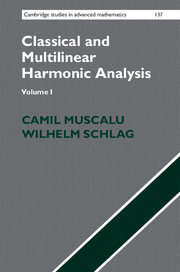Book contents
- Frontmatter
- Contents
- Preface
- Acknowledgements
- 1 Fourier series: convergence and summability
- 2 Harmonic functions; Poisson kernel
- 3 Conjugate harmonic functions; Hilbert transform
- 4 The Fourier transform on ℝd and on LCA groups
- 5 Introduction to probability theory
- 6 Fourier series and randomness
- 7 Calderón–Zygmund theory of singular integrals
- 8 Littlewood–Paley theory
- 9 Almost orthogonality
- 10 The uncertainty principle
- 11 Fourier restriction and applications
- 12 Introduction to the Weyl calculus
- References
- Index
12 - Introduction to the Weyl calculus
Published online by Cambridge University Press: 05 February 2013
- Frontmatter
- Contents
- Preface
- Acknowledgements
- 1 Fourier series: convergence and summability
- 2 Harmonic functions; Poisson kernel
- 3 Conjugate harmonic functions; Hilbert transform
- 4 The Fourier transform on ℝd and on LCA groups
- 5 Introduction to probability theory
- 6 Fourier series and randomness
- 7 Calderón–Zygmund theory of singular integrals
- 8 Littlewood–Paley theory
- 9 Almost orthogonality
- 10 The uncertainty principle
- 11 Fourier restriction and applications
- 12 Introduction to the Weyl calculus
- References
- Index
Summary
Motivation, definitions, basic properties
Quantization
The basic concept from which we would like to start is that of quantization. This name originates in the observation, at the turn of the twentieth century, that energy is exchanged in discrete units. Mathematically, quantization refers to a procedure by which one passes from functions on the phase space of classical mechanics in the Hamiltonian formulation (the cotangent bundle of a manifold) to operators on a Hilbert space, the phase space of quantum mechanics. As this is not a physics textbook, we will not motivate – let alone explore – this quantization problem in any generality or depth. Moreover, we assure the reader that this chapter is self-contained (up to knowing the Fourier transform and calculus) and that no knowledge of physics will be required to follow it. From a mathematical perspective the calculus of pseudodifferential operators (ΨDOs), which is a result of such a quantization procedure, is an essential tool in elliptic PDEs, through microlocal techniques, whereas Fourier integral operators (FIOs) arise naturally in hyperbolic PDEs.
The only information we start from is the following basic list of correspondences on the phase space ℝ2d for the variables (x, ξ) (we will not discuss here the motivation for these correspondences from physics):
xj ↦ Xj,
ξj ↦ Dj,
1 ↦ Id.
Here Xj is the (unbounded) operator on L2(ℝd) given by Xj(f)(x) = xjf(x) and
alternatively, Djf = (ξjf)∨ at least for Schwartz functions.
- Type
- Chapter
- Information
- Classical and Multilinear Harmonic Analysis , pp. 315 - 359Publisher: Cambridge University PressPrint publication year: 2013



